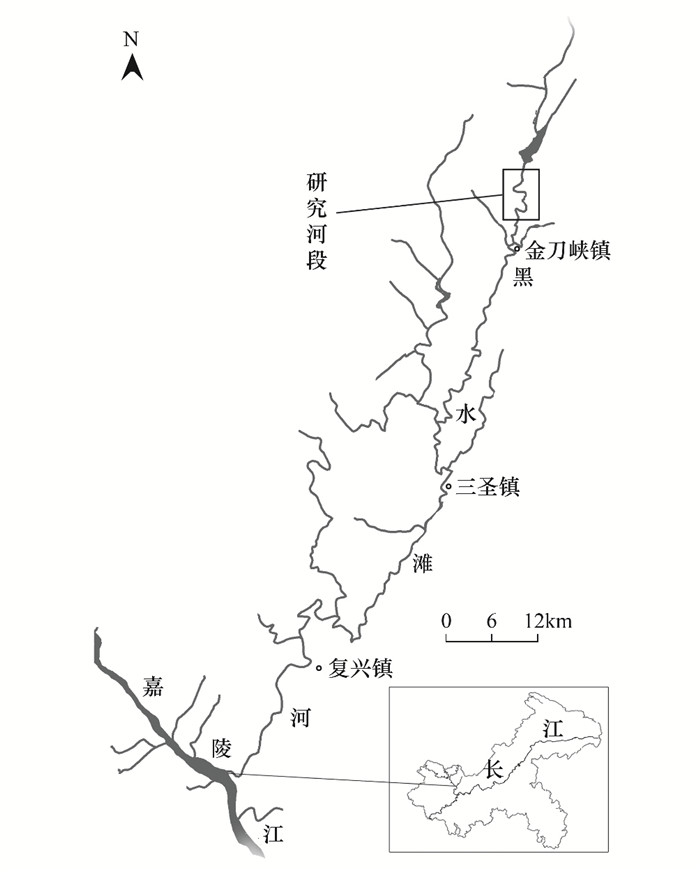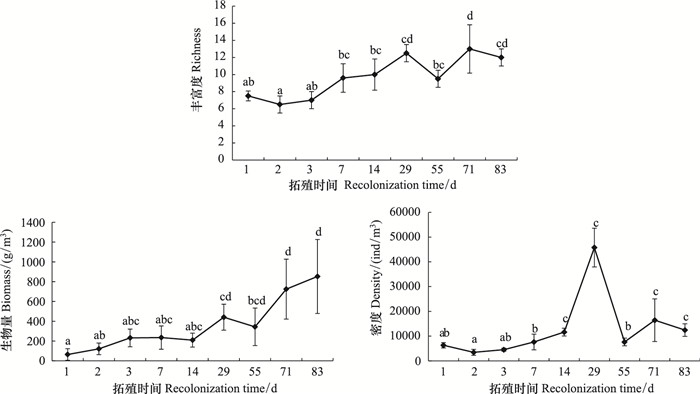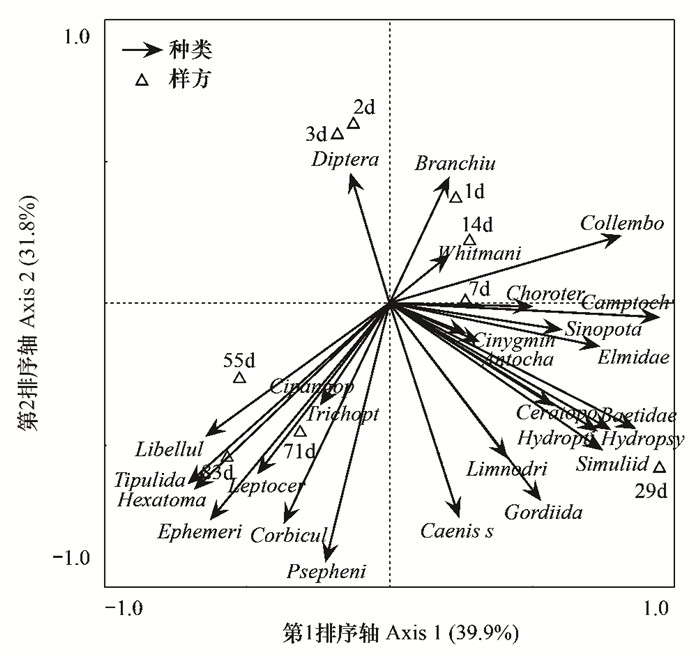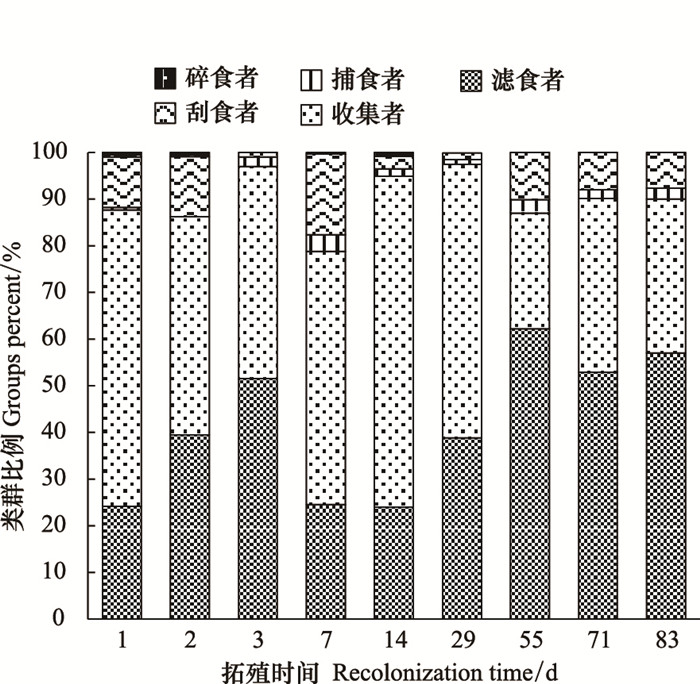文章信息
- 张跃伟, 袁兴中, 刘红, 任海庆, 邓伟, 岳俊生
- ZHANG Yuewei, YUAN Xingzhong, LIU Hong, REN Haiqing, DENG Wei, YUE Junsheng.
- 山地河流浅滩生境潜流层大型无脊椎动物群落拓殖
- Recolonization of hyporheic microinvertebrate communities in a mountain stream
- 生态学报[J]. 2016, 36(15): 4873-4880
- Acta Ecologica Sinica[J]. 2016, 36(15): 4873-4880
- http://dx.doi.org/10.5846/stxb201501050026
-
文章历史
- 收稿日期: 2015-01-05
- 网络出版日期: 2015-11-16
2. 西南资源开发及环境灾害控制工程教育部重点实验室, 重庆 400030;
3. 重庆大学资源及环境科学学院, 重庆 400030
2. Ministry of Education Key Laboratory for the Exploitation of Southwestern Resources and the Environmental Disaster Control Engineering, Chongqing University, Chongqing 400030, China;
3. College of Resource and Environmental Science, Chongqing University, Chongqing 400030, China
干扰是自然界普遍存在的现象,生态系统一般都处于不断地被扰动的状态之中,一个群落或生态系统其相对稳定的状态不仅决定于其本身的抗干扰能力,也决定于其受到干扰后的恢复能力[1-2]。潜流层是地表水和地下水相互作用的群落交错区,生物多样性丰富,是河流生态系统的重要组成部分,栖息于潜流层中的大型无脊椎动物对河流生态系统的结构和功能发挥着重要作用[3-4]。自然因素(洪水、干旱等)和人为活动(采矿、农业、林业、城市化以及河道整治等)均会对潜流层大型无脊椎动物群落组成及分布造成干扰[5-10]。
通常,激流生境受到较小的扰动后,潜流层无脊椎动物群落恢复到未受扰动前的状态所需时间较短[6, 11-13],而无脊椎动物迁移到新生境中繁殖并达到稳定状态所需要的时间则相对较长[14-17]。目前,对于无脊椎动物在潜流层中的恢复过程和机理还不是很明确,已有的研究表明受扰动后群落中非典型的潜流层动物比典型的潜流层动物恢复更快,一些恢复能力较强的种类首先繁殖,这与动物的生活史和适应能力有关[12, 18-19]。研究者较多的使用人工基质采样器研究无脊椎动物群落在潜流层中的拓殖[14-16]。包埋的人造基质采样器相当于人为扰动形成新的斑块生境。本研究以典型的山地河流——黑水滩河上游河段为研究区域,选择浅滩生境包埋人工基质,研究潜流层大型无脊椎动物群落在受扰动之后的恢复过程,包括群落结构的变化和恢复时间,探讨群落的恢复机制及影响因素。
1 研究区域及研究方法 1.1 研究区域概况黑水滩河是嘉陵江北岸一级支流,位于重庆市北碚区东部,发源于华蓥山宝顶南坡,南流穿胜天湖水库经金刀峡镇、三圣镇、复兴镇,在水土镇东南狮子口注入嘉陵江。本研究选择的区域位于黑水滩河上游祝家湾河段(N30°0′42.71", E106°39′17.86",海拔327 m),浅滩生境,为我国西南部典型的山地河流河段,人为干扰较少,河流比降16.14‰,河床结构完整,底质以砾石、卵石为主,水质清洁,河谷呈“U”形(图 1)。

|
| 图 1 研究区域及调查河段位置示意图 Fig. 1 Drainage map of Heishuitan river and location of sampling reaches |
(1)实验设计及采样方法
本研究于2014年4—7月进行,这个时节无脊椎动物开始大量繁殖,且气候条件相对稳定,环境因素对实验的影响较小。潜流层大型无脊椎动物采集使用人工基质法[4],采样器为自制的类似于Nelson和Roline[17]所使用的采样器,主要由两个可以相互嵌套的圆桶构成,外桶为均匀分布圆孔的PVC管,高40 cm,内径16 cm,上下不封口,内桶以粗钢丝做骨架缠绕钢丝筛网,上端不封口,下端用钢丝筛网封口。4月份在研究河段包埋采样器,包埋在平水期能被河水淹没的区域,尽量靠近河床中心,采样器顶端与河床表面齐平,每个采样器的间距大于2 m。共包埋9组,每组6个采样器,分别于1、2、3、7、14、29、55、71、83 d后采集每组中的大型无脊椎动物。采集时依次从下游开始提取采样器,用40目孔径铜筛挑选大型无脊椎动物,挑出的无脊椎动物标本装入30 mL采样瓶,用75%酒精保存,带回室内镜检分类、计数、鉴定、称重。物种尽可能鉴定至最低的分类单元。称重前先用滤纸吸干标本体表液体,用万分之一电子天平称重,软体动物不去壳称重。
(2)功能摄食类群划分
功能摄食类群划分为刮食者(SC)、碎食者(SH)、滤食者(CF)、收集者(CG)和捕食者(PR)五类[4, 20-21]。
1.3 数据分析本研究选取物种密度、生物量、丰富度、Shannon-Wiener多样性、Pielou均匀度等指数[22]分析不同拓殖时间段大型无脊椎动物的群落特征。选用SPSS 19.0中的One-way ANOVA对大型无脊椎动物密度、生物量、丰富度、物种多样性指标数据进行差异显著性检验。其中密度和生物量的原始数据经检验方差不齐,经SPSS转换数据(个案排秩)后进行显著性检验。两两比较使用Student Newman Keuls(SNK)法,显著性水平取0.05。主成分分析(principal component analysis, PCA)及制图用CANOCO4.5软件完成。
2 结果与分析 2.1 群落结构本次研究共采集到大型无脊椎动物3500多头,合计28种,分属4门,13目,21科(表 1)。物种丰富度从第1—29天呈增加趋势,第29—83天呈波动状态,趋于稳定;群落的生物量总体呈增加趋势;群落个体密度在第7—29天呈“J”型增长,在第29天后骤然降低,之后呈波动趋势(图 2)。群落的物种丰富度、密度和生物量在29 d之前均呈增加趋势,第29、71天和第83天时则没有显著性差异(P>0.05)。本研究中第55天的突变(各参数均突然降低)可能与环境条件的突变有关,由这些变化可以预测,潜流层大型无脊椎动物群落在第55天之后开始趋于稳定。对所有调查样方(采样器)中物种的出现频率统计发现,出现频率大于50%的有7种,分别为摇蚊(Camptochironomus sp., 100%)、河蚬(Corbicula fluminea, 95%)、四节蜉(Baetis sp., 79%)、动蜉(Cinygmina sp., 76%)、纹石蛾(Hydropsyche sp., 64%)、细蜉(Caenis sp., 62%)和扁泥甲科一种(Psephenidae, 50%)。对各拓殖时间段大型底栖动物相对多度分析表明调查河段中共有6个优势种(相对多度大于5%)[23]:分别为摇蚊、河蚬、四节蜉、动蜉、纹石蛾、扁泥甲科一种(表 1)。
| 类群Groups | FFG* | 相对多度Relative abundance/% | ||||||||
| 1d | 2d | 3d | 7d | 14d | 29d | 55d | 71d | 83d | ||
| 线形动物门Nematomorpha | ||||||||||
| 铁线虫科Gordiidae | UN | 0.27 | 0.88 | 0.41 | 0.38 | 0.33 | ||||
| 环节动物门Annelida | ||||||||||
| 颤蚓目Tubificida | ||||||||||
| 颤蚓科Tubificidae | ||||||||||
| 水丝蚓属Limnodrilus sp. | CG | 0.98 | 0.20 | 0.66 | ||||||
| 苏氏尾鳃蚓Branchiura sowerbyi | CG | 0.92 | 0.33 | 0.27 | ||||||
| 颚蛭目Gnathobdellida | ||||||||||
| 水蛭科Hirudinidae | ||||||||||
| 水蛭Whitmania pigra | PR | 0.27 | ||||||||
| 软体动物门Mollusca | ||||||||||
| 腹足纲Gastropoda | ||||||||||
| 扁蜷螺科Planorbidae | CF | 0.33 | ||||||||
| 田螺科Viviparidae | ||||||||||
| 中国圆田螺Cipangopaludina chinensis | CF | 0.38 | ||||||||
| 瓣鳃纲Lamellibranchia | ||||||||||
| 蚬科Corbiculidae | ||||||||||
| 河蚬Corbicula fluminea | CF | 7.39 | 27.52 | 42.00 | 13.68 | 18.45 | 5.44 | 57.72 | 41.67 | 46.18 |
| 节肢动物门Arthropoda | ||||||||||
| 蜉蝣目Ephemeroptera | ||||||||||
| 扁蜉科Heptageniidae | ||||||||||
| 动蜉属Cinygmina sp. | SC | 10.34 | 12.84 | 16.61 | 1.87 | 0.48 | 1.63 | 3.03 | 2.66 | |
| 四节蜉科Baetidae | ||||||||||
| 四节蜉属Baetis sp. | CG | 20.69 | 7.34 | 7.00 | 25.08 | 7.75 | 18.15 | 3.66 | 8.33 | 4.98 |
| 蜉蝣科Ephemeridae | CG | 0.65 | 0.07 | 8.94 | 12.12 | 18.94 | ||||
| 细裳蜉科Ephemeroptera | ||||||||||
| 似宽基蜉属Choroterpides sp. | CG | 1.97 | 0.92 | 2.00 | 2.61 | 1.07 | 0.27 | 2.03 | 0.38 | 0.33 |
| 细蜉科Caenidae | ||||||||||
| 细蜉属 Caenis sp. | CF | 2.46 | 2.93 | 2.14 | 0.61 | 2.44 | 3.03 | 2.33 | ||
| 双翅目Diptera | 1.00 | |||||||||
| 蚋科Simuliidae | CF | 0.49 | 0.33 | 1.50 | 0.76 | |||||
| 大蚊科Tipulidae | PR | 0.41 | 0.38 | 1.00 | ||||||
| 朝大蚊属Antocha sp. | CG | 1.00 | 0.98 | 1.07 | 0.07 | 0.38 | 0.33 | |||
| 黑大蚊属Hexatoma sp. | PR | 0.33 | 1.22 | 0.76 | 1.00 | |||||
| 摇蚊科Chironomidae | ||||||||||
| 摇蚊属Camptochironomus sp. | CG | 40.89 | 35.78 | 35.00 | 23.13 | 59.89 | 39.70 | 9.76 | 14.39 | 3.99 |
| 蠓科Ceratopogonidae | PR | 0.49 | 2.00 | 0.53 | 0.88 | 0.81 | 0.76 | |||
| 毛翅目Trichoptera | ||||||||||
| 纹石蛾科Hydropsychidae | ||||||||||
| 纹石蛾属Hydropsyche sp. | CF | 13.79 | 11.93 | 9.00 | 7.49 | 2.94 | 30.32 | 1.63 | 6.44 | 7.97 |
| 小石蛾科Hydroptilidae | SC | 0.20 | ||||||||
| 广翅目Megaloptera | ||||||||||
| 鱼蛉科Corydalidae | CG | 1.83 | 0.33 | 0.27 | 0.07 | 0.41 | 1.52 | 3.65 | ||
| 鞘翅目Coleoptera | ||||||||||
| 扁泥甲科Psephenidae | SC | 0.49 | 1.00 | 0.65 | 0.80 | 0.75 | 8.54 | 4.92 | 4.98 | |
| 溪泥甲科Elmidae | CF | 0.33 | 0.80 | 0.14 | ||||||
| 蜻蜓目Odonata | ||||||||||
| 蜻科Libellulidae | PR | 0.41 | 0.00 | 0.33 | ||||||
| 弹尾目Collembola | SH | 0.99 | 0.92 | 0.33 | 0.80 | 0.14 | ||||
| 十足目Decapoda | ||||||||||
| 锯齿华溪蟹Sinopotamon denticulatum | PR | 3.26 | 0.80 | 0.14 | ||||||
| FFG:功能摄食群functional feeding groups,CF:滤食者collector-filterers,CG:收集者collector-gatherers,PR:捕食者Predators,SC:刮食者scrapers,SH:碎食者shredders,UN:未确定uncertain | ||||||||||

|
| 图 2 不同拓殖时间段大型无脊椎动物的丰富度、生物量和密度(均值±标准差) Fig. 2 Fig.2 Species richness index, biomass and density in different recolonization time (mean±SD) |
Shannon-Wiener多样性指数介于1.32—1.88之间,第14天最低,且显著的低于第7、71和83天(P < 0.05);Pielou均匀度指数介于0.58—0.83之间,前4个时间段显著的高于14和29 d(P < 0.05),第29天最低,之后趋于波动状态。这两个指数在14和29 d降低,与该时间段一些种类的密度骤然增加有关,两个指数在第55、71和83天之间均没有显著性差异(P>0.05)(图 3)。可以推断,潜流层大型无脊椎动物群落物种多样性在第55天之后趋于稳定状态。

|
| 图 3 不同拓殖时间段大型无脊椎动物物种多样性指标(均值±标准差) Fig. 3 Biodiversity index for macroinvertebrate in different recolonization time (mean±SD) |
主成分分析就是将一个综合考虑多种性状的问题,在尽量少损失原有信息的前提下,解析出主要影响变量的方法。对9个拓殖时间段28种大型无脊椎动物的多度进行PCA分析,物种和样方的二维排序图结果表明第1和第2排序轴对群落变化的解释度达到71.7%(图 4),能很好的反应不同拓殖时间段物种的分布。由图 1.3可见,9个拓殖时间段的大型无脊椎动物群落聚为3类,第1、2、3、7、14天的群落聚为1类,第55、71、83天的群落聚为1类,第29天的群落单独为一类,且与其它两类距离较远,说明第29天群落的多度发生了急剧的变化,造成这种变化的原因是一些种类骤然的数量猛增,由图 4可以看到纹石蛾、四节蜉、摇蚊、蚋科(Simuliidae)、和小石蛾科(Hydroptilidae)等在第29天群落中的多度较高,结合这些种类多度的调查数据可以确定造成这种变化的种类为纹石蛾、四节蜉和摇蚊。第55、71、83天的群落聚为1类,且相互距离较近,说明这3个时间段的群落结构相似,群落在55 d后趋于稳定。

|
| 图 4 不同拓殖时间段大型无脊椎动物PCA二维排序图 Fig. 4 Principal components analysis ordination diagram of samples based on 28 macroinvertebrate taxa |
本研究所采集的大型无脊椎动物按功能摄食类群划分,以集食者为主,包括滤食者和收集者,分别占群落个体总数的39.81%和52.67%。除第3天外,1—29 d群落中收集者的比例高于滤食者,29 d之后群落中滤食者的比例高于收集者。除前2 d外,之后的其它各时间段群落中均有捕食者存在,比例介于1%—4%之间;碎食者仅存在于1、2和14 d的群落中,且所占比例较低,均为1%;刮食者在各个调查时间段均存在,在群落中比例相对较低(图 5)。

|
| 图 5 不同拓殖时间段大型无脊椎动物功能摄食类群所占比例 Fig. 5 Percentage of macroinvertebrate functional feeding groups in different recolonization time |
研究者发现自然种群变化过程中许多种类有时会出现骤然的数量猛增,呈大爆发,随后又大崩溃[24],本研究中群落的个体密度在第7—29天开始呈爆发式增长,在第29天达到最大值,随后急剧降低。群落个体密度的爆发式增长与纹石蛾、四节蜉和摇蚊个体数量的急剧增加有关。Hancock[12]在研究受大洪水扰动后潜流层无脊椎动物群落的恢复过程中也发现寡毛纲和剑水蚤类无脊椎动物的数量在61 d后爆发,随后降低。本研究中群落个体密度在第29—55天急剧降低,除了受到环境容量的限制和种间竞争的相互影响外,也受到外部环境因素的影响,在此期间,连续降雨导致该河段多次受到洪水的影响。Olsen和Townsend[11]在山地河流研究表明受洪水影响后潜流层无脊椎动物群落的个体密度降低。Hancock[12]的研究也显示了相同的结果,受洪水影响后2个调查断面无脊椎动物的密度分别下降到洪水前的83%和67%。
扰动前后的物种密度常被用来指示群落的恢复状态[12, 14, 25],Coleman和Hynes[14]的研究发现除摇蚊科无脊椎动物密度在7 d后达到最大值外,其他动物的密度在28 d后仍然增加,指出群落要达到稳定状态可能还需要更长的时间。但在较长的时间尺度,受到气温等环境因素及动物自身生活史特征的影响单一的密度指标并不能准确的反应群落的恢复状态,Morris等[15]的研究结果显示同一时间段的调查结果显示间隔28、61、93 d的群落个体密度没有显著差异,但不同时间段的调查结果却显示28—93 d个体密度存在显著差异。本研究综合分析了物种密度、生物量、丰富度、Shannon-Wiener多样性指数和Pielou均匀度指数的变化特征,并对不同拓殖时间段物种多度进行了PCA分析,表明潜流层大型无脊椎动物群落在55 d后趋于稳定。
潜流层因其特殊的生境,生活在其中的大型无脊椎动物主要是水生昆虫的幼虫以及软体动物门和环节动物门的一些种类,且个体较小,外形细长或扁平,身体柔软或具有坚硬外壳的种类[26-27]。本研究河段潜流层中大型无脊椎动物群落主要由摇蚊、河蚬、四节蜉、动蜉、纹石蛾和扁泥甲科的一种构成。水生昆虫是主要类群,这与Olsen和Townsend[28]在山地河流中的研究一致,并认为以甲壳类为主的潜流动物没有成为群落的优势种群,可能是由于水流和河床的不稳定因素造成的。
潜流层大型无脊椎动物的功能摄食类群中个体数量最多的是滤食者、收集者和刮食者[29-30]。Xu等[16]在拒马河的拓殖实验也表明滤食者和收集者是最优势的类群,其次是刮食者。本研究中滤食者和收集者在所有拓殖时间段均是优势类群,刮食者次之,在各个群落中所占比例较低。这与潜流层狭小的生存空间和食物来源有关,营养物质大多随水流进入潜流层,更利于滤食者和收集者摄食[26]。
3.2 群落恢复机制群落结构的变化(表 1, 图 2和图 4)可以部分地反映潜流层大型无脊椎动物在一个新斑块生境中拓殖的过程:第1天斑块周围生境中的大型无脊椎动物主动或被动(水流等的作用)的迁入;第2天群落个体密度略微下降,一些不适应该生境的物种或死亡、或迁出;第3—7天群落个体密度持续增加;第7—29天群落个体密度呈“J”型增长,适应该生境的物种大量繁殖;如双翅目一种、水蛭和小石蛾科一种分别仅在第3天、7天和第14天时出现,纹石蛾、四节蜉和摇蚊在第29天时多度急剧增加。第29—55天期间受洪水的影响一些群落个体或迁出或死亡,密度急剧降低;如锯齿华溪蟹、苏氏尾鳃蚓、溪泥甲科一种和弹尾目一种仅在55 d前分布。55 d之后群落个体密度呈波动状态,趋于稳定。在整个拓殖过程的各阶段均伴随着个体的迁入、迁出、出生和死亡等,不同的阶段各参数所起的作用不尽相同,初期迁入起到主导作用,中期(爆发期,7—28 d)出生率起主导作用,随后死亡率发挥的作用更大,稳定期各参数的作用可能比较均衡。
激流生境动物群落的恢复能力主要与以下几方面的原因有关:①动物的生活史特征;②上、下游或临近沉积层中动物进入受扰动生境的难易程度;③动物对于受扰动生境的适应能力;④扰动持续的时间和强度,包括河流自身对污染的净化能力等[18]。受这些因素的影响不同环境条件下潜流层无脊椎动物群落受扰动后恢复的时间不尽相同。群落中非典型的潜流层动物比典型的潜流层动物恢复更快[12],典型潜流层动物中一些无性繁殖的种类(如涡虫类)恢复较快,而占典型潜流层动物中绝大多数的甲壳类则恢复较慢[12, 19, 31]。本研究中,拓殖初期(1—7 d)潜流层的结构是影响着无脊椎动物迁入的主要因素,;中期,7—29 d动物的生活史特征是主要影响因素,29—55 d洪水扰动持续的时间和强度是主要影响因素;稳定期,55 d之后群落可能受到上述各因素的综合影响。群落的拓殖过程是一个群落自身恢复能力和外部环境影响相互作用的过程,外部的环境影响包括环境容量、干旱和洪水的影响等,群落的恢复能力与物种的生活史、适应能力及种间和种内的相互作用有关。明确各因素在整个拓殖过程中的作用是未来研究的重点。
| [1] | 岳天祥, 马世骏. 生态系统稳定性研究[J]. 生态学报 , 1991, 11 (4) : 361–366. |
| [2] | 柳新伟, 周厚诚, 李萍, 彭少麟. 生态系统稳定性定义剖析[J]. 生态学报 , 2004, 24 (11) : 2635–2640. |
| [3] | 袁兴中, 罗固源. 溪流生态系统潜流带生态学研究概述[J]. 生态学报 , 2003, 23 (5) : 956–964. |
| [4] | 张跃伟, 袁兴中, 刘红, 任海庆. 溪流潜流层大型无脊椎动物生态学研究进展[J]. 应用生态学报 , 2014, 25 (11) : 3357–3365. |
| [5] | Marchant R. Vertical distribution of benthic invertebrates in the bed of the thomson river, victoria[J]. Australian Journal of Marine And Freshwater Research , 1988, 39 (6) : 775–784. DOI:10.1071/MF9880775 |
| [6] | Boulton A J, Stanley E H. Hyporheic processes during flooding and drying in a sonoran desert stream. II: Faunal dynamics[J]. Archiv Für Hydrobiologie , 1995, 134 (1) : 27–52. |
| [7] | Clinton Sandra M, Grimm Nancy B, Fisher Stuart G. Response of a hyporheic invertebrate assemblage to drying disturbance in a desert stream[J]. Journal of the North American Benthological Society , 1996, 15 (4) : 700–712. DOI:10.2307/1467817 |
| [8] | Hancock Peter J. Human impacts on the stream-groundwater exchange zone[J]. Environmental Management , 2002, 29 (6) : 763–781. DOI:10.1007/s00267-001-0064-5 |
| [9] | Illyová Marta, Beracko Pavel, Krno Ii'ja. Influence of land use on hyporheos in catchment streams of the Velka Fatra Mts[J]. Biologia , 2011, 66 (2) : 320–327. |
| [10] | Moldovan Oana Teodora, Levei Erika, Marin Constantin, Banciu Manuela, Banciu Horia Leonard, Pavelescu Claudia, Brad Traian, Cîmpean Mirela, Meleg Ioana, Iepure Sanda, Povară Ioan. Spatial distribution patterns of the hyporheic invertebrate communities in a polluted river in romania[J]. Hydrobiologia , 2011, 669 (1) : 63–82. DOI:10.1007/s10750-011-0651-2 |
| [11] | Olsen Dean A, Townsend Colin R. Flood effects on invertebrates, sediments and particulate organic matter in the hyporheic zone of a gravel-bed stream[J]. Freshwater Biology , 2005, 50 (5) : 839–853. DOI:10.1111/fwb.2005.50.issue-5 |
| [12] | Hancock Peter J. The response of hyporheic invertebrate communities to a large flood in the hunter river, new south wales[J]. Hydrobiologia , 2006, 568 (1) : 255–262. DOI:10.1007/s10750-006-0110-7 |
| [13] | M-JDoleOlivier, Marmonier P, Beffy J-L. Response of invertebrates to lotic disturbance: Is the hyporheic zone a patchy refugium?[J]. Freshwater Biology , 1997, 37 (2) : 257–276. DOI:10.1046/j.1365-2427.1997.00140.x |
| [14] | Coleman Mary J, Hynes H B N. The vertical distribution of the invertebrate fauna in the bed of a stream[J]. Limnology and Oceanography , 1970, 15 (1) : 38–40. |
| [15] | Morris D L, Brwker M P. The vertical distribution of macro-invertebrates in the substratum of the upper reaches of the River Wye, Wales[J]. Freshwater Biology , 1979, 9 (6) : 573–583. DOI:10.1111/fwb.1979.9.issue-6 |
| [16] | Xu M Z, Wang Z Y, Pan B Z, Zhao N. Distribution and species composition of macroinvertebrates in the hyporheic zone of bed sediment[J]. International Journal of Sediment Research , 2012, 27 (2) : 129–140. DOI:10.1016/S1001-6279(12)60022-5 |
| [17] | Mark Nelson S, Roline Richard A. Relationships between metals and hyporheic invertebrate community structure in a river recovering from metals contamination[J]. Hydrobiologia , 1999, 397 : 211–226. DOI:10.1023/A:1003734407788 |
| [18] | David Yount J, Niemi Gerald J. Recovery of lotic communities and ecosystems from disturbance-a narrative review of case-studies[J]. Environmental Management , 1990, 14 (5) : 547–569. DOI:10.1007/BF02394709 |
| [19] | Fritz Ken M, Dodds Walter K. Resistance and resilience of macroinvertebrate assemblages to drying and flood in a tallgrass prairie stream system[J]. Hydrobiologia , 2004, 527 (1) : 99–112. DOI:10.1023/B:HYDR.0000043188.53497.9b |
| [20] | 段学花.河流水沙对底栖动物的生态影响研究[D].北京:清华大学, 2009. |
| [21] | Michael TBarbour, Jeroen Gerritsen, Blaine D Snyder, James B Stribling. Rapid Bioassessment Protocols for Use in Streams and Wadeable River: Periphyton, Benthic Macroinvertebrates, and Fish. 2nd ed. Washington, DC: USEPA, 1999: 340-380. |
| [22] | 段学花, 王兆印, 程东升. 典型河床底质组成中底栖动物群落及多样性[J]. 生态学报 , 2007, 27 (4) : 1664–1672. |
| [23] | 王强, 袁兴中, 刘红. 山地河流浅滩深潭生境大型底栖动物群落比较研究-以重庆开县东河为例[J]. 生态学报 , 2012, 32 (21) : 6726–6736. |
| [24] | 牛翠娟, 娄安如, 孙儒泳, 李庆芬. 基础生态学 , 2007 : 77–80. |
| [25] | Palmer Margaret A, Bely Alexandra E, Berg K E. Response of invertebrates to lotic disturbance: a test of the hyporheic refuge hypothesis[J]. Oecologia , 1992, 89 (2) : 182–194. DOI:10.1007/BF00317217 |
| [26] | Boulton A J. The Subsurface Macrofauna//Jones J B, Mulholland P J, eds. Stream and Ground Water. San Diego: Academic Press, 1999: 337-361. |
| [27] | Malard F, Galassi D, Lafont M, Doledec Sylvain, Ward J V. Longitudinal patterns of invertebrates in the hyporheic zone of a glacial river[J]. Freshwater Biology , 2003, 48 (10) : 1709–1725. DOI:10.1046/j.1365-2427.2003.01118.x |
| [28] | Olsen Dean A, Townsend Colin R. Hyporheic community composition in a gravel-bed stream: influence of vertical hydrological exchange, sediment structure and physicochemistry[J]. Freshwater Biology , 2003, 48 (8) : 1363–1378. DOI:10.1046/j.1365-2427.2003.01097.x |
| [29] | Hose Grant Christopher, Jones Peter, Lim Richard P. Hyporheic macroinvertebrates in riffle and pool areas of temporary streams in south eastern Australia[J]. Hydrobiologia , 2005, 532 (1/3) : 81–90. |
| [30] | Bunn Stuart E. Spatial and temporal variation in the macroinvertebrate fauna of streams of the northern jarrah forest, Western Australia: functional organization[J]. Freshwater Biology , 1986, 16 (5) : 621–632. DOI:10.1111/fwb.1986.16.issue-5 |
| [31] | Marmonier P, des Chttelliers Creuzé M. Effects of spates on interstitial assemblages of the rhône river-importance of spatial heterogeneity[J]. Hydrobiologia , 1991, 210 (3) : 243–251. DOI:10.1007/BF00034683 |
 2016, Vol. 36
2016, Vol. 36




